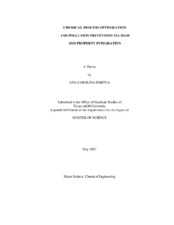| dc.description.abstract | The process industries such as petrochemicals, chemicals and pharmaceuticals, among
others, consume large amounts of material and energy resources. These industries are also
characterized by generating enormous amounts of waste that significantly contribute to the
pollution of the environment. Integrated process design is a very effective technique in
conserving process resources and preventing pollution. The design and environmental
constraints may involve a variety of component- and property-based restrictions. To date,
most techniques have been developed to handle process constraints which is either
composition-based (via mass integration) or property-based. No work has been reported to
handle the synthesis of resource conservation network that is governed by both constraints.
The objective of this work is to develop a systematic and cost-effective design technique
that is aimed at minimizing the consumption of fresh resources and the discharge of
pollutants simultaneously. Because of the nature of the component- and property-based
constraints, this approach is based on mass and property integration and takes into account
the process constraints and also environmental regulations. In this research work, a new approach has been developed to simultaneously address
component-based recycle constraints as well as property-based discharge constraints. The
proposed optimization technique is intended to minimize the consumption of fresh
resources, the pollutant content in the waste streams, and the operational and waste
treatment costs. Additionally, a mixed-integer nonlinear programming (MINLP)
formulation is solved for a case study of phenol production from cumene hydroperoxyde to
illustrate the new problem and devised solution algorithm. | en |


